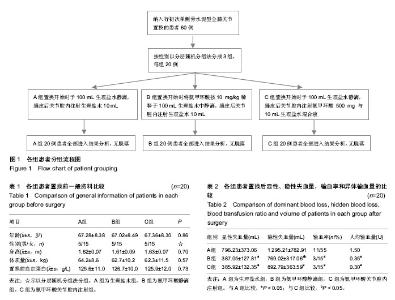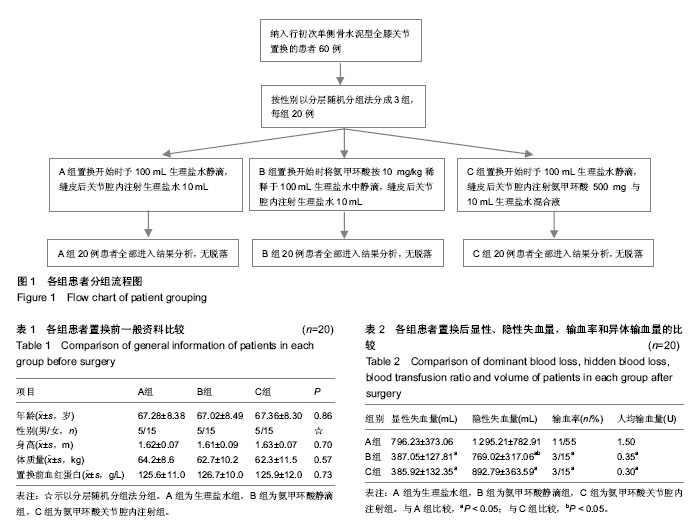| [1] Ferraris VA, Brown JR, Despotis GJ, et al. 2011 update to the Society of Thoracic Surgeons and the Society of Cardiovascular Anesthesiologists blood conservation clinical practice guidelines. Ann Thorac Surg. 2011;91(3):944-982.
[2] Barwell J, Anderson G, Hassan A, et al.The effects of early tourniquet release during total knee arthroplasty: a prospective randomized double-blind study. J Bone Joint Surg Br. 1997;79:265-268.
[3] Good L, Peterson E, Lisander B. Tranexamic acid decreases extermal blood loss but not hidden blood loss in total knee replacement. Br J Anaesth. 2003;90(5):596-599.
[4] Sehat KR, Evans R. Newman JH. How much blood is really lost in total knee arthroplasty? Correct blood loss management should take hidden loss into account. Knee. 2000;7(3):151-155.
[5] Hippala ST, Stird LJ, Wennerstrand MI, et al. Tranesamic acid radically decreases blood loss and trandfusions associated with tatal knee arthroplasty. Anesth Analg. 1997;84(4): 839-844.
[6] Jansen AJ, Andreica S, Claeys M, et al.Use of tranexamic acid for an effective blood conservation strategy after total knee arthropalsty. Br J Anaesth. 1999;83(4):596-601.
[7] Menitove JE. Transfusion related acute lung injury (TRALI):a review. Mo Med. 2007;104(3):270-275.
[8] Fuller AK,Uglik KM, Savage WJ, et al. Bacterial culture reduces but does not eliminate the risk of septic transtusion reactions to single-donor paltelets. Transfusion. 2009;49(12): 2588-2593.
[9] Tobias JD. Strategies for minimizing blood loss in orthopedic surgery. Semin Hematol. 2004;41(1 Suppl 1):S145-156.
[10] Sabatini L, Trecci A, Imarisio D, et al. Fibrin tissue dhesive reduces postoperative blood loss in total knee arthroplasty. J Orthop Traumatol. 2012;13(3):145-151.
[11] Hawi N, Kendoff DO, Hessling U, et al. Effectiveness of an autologous transfusion system following cemented and non-cemented revisions of total hip arthroplasty. Int Orthop. 2014;38(8):1603.
[12] Horstmann WG, Swierstra MJ, Ohanis D, et al. Favourable results of a new intraoperative and postoperative filtered autologous blood re-transfusion system in total hip arthroplasty: a randomised controlled trial. Int Orthop. 2014;38(1):13.
[13] Panteli M, Papakostidis C, Dahabreh Z, et al. Topical tranexamic acid in total knee replacement: A systematic review and meta-analysis. Knee. 2013;20:300-309.
[14] McCormack PL. Tranexamic acid: a review of its use in the treatment of hyperfibrinolysis. Drugs. 2012;5:585-617.
[15] Georgiadis AG, Muh SJ, Silverton CD, et al. A prospective double-blind placebo controlled trial of topical tranexamic acid in total knee arthroplasty. J Arthroplasty. 2013;8:78-82.
[16] Konig G, Hamlin BR, Waters JH. Topical tranexamic acid reduces blood loss and transfusion rates in total hip and total knee arthroplasty.J Arthroplasty. 2013;9:1473-1476.
[17] Ker K, Edwards P, Perel P, et al. Effect of tranexamic acid on surgical bleeding: systematic review and cumulative meta-analysis. BMJ. 2012;344:e3054.
[18] Soni A, Saini R, Gulati A, et al. Comparison Between Intravenous and Intra-articular Regimens of Tranexamic Acid in Reducing Blood Loss During Total Knee Arthroplasty. J Arthroplasty. 2014.
[19] Patel JN, Spanyer JM, Smith LS, et al. Comparison of Intravenous versus Topical Tranexamic Acid in Total Knee Arthroplasty: A Prospective Randomized Study. J Arthroplasty. 2014.
[20] Zhou XD, Tao LJ, Li J, et al. Do we really need tranexamic acid in total hip arthroplasty? A meta?analysis of nineteen randomized controlled trials. Arch Orthop Trauma Surg. 2013;133(7):1017-1027.
[21] Raviraj A, Anand A, Chakravarthy M, et al. Tranexamic acid reduces blood loss in simultaneous bilateral total knee arthroplasty: a randomized control trial.Eur J Orthop Surg Traumatol. 2013;22:381-386.
[22] Gillette BP, DeSimone LJ, Trousdale RT,et al. Low Risk of Thromboembolic Complications With Tranexamic Acid After Primary Total Hip and Knee Arthroplasty. Clin Orthop Relat Res. 2013;471(1):150-154.
[23] Alshryda S, Sarda P, Sukeik M, et al. Tranexamic acid in total knee replacement: a systematic review and meta-analysis. J Bone Joint Surg Br. 2011;93(12):1577-1585.
[24] Eubanks JD. Antifibrinolytics in major orthopaedic surgery. J Am Acad Orthop Surg. 2010;18(3):132-138.
[25] Yang ZG, Chen WP, Wu LD. Effectiveness and safety of tranexamic acid in reducing blood loss in total knee arthroplasty: a meta-analysis. J Bone Joint Surg Am. 2012; 94(13):1153-1159.
[26] 马金辉,孙伟,高福强.关节腔注射氨甲环酸单侧全膝关节置换者的失血量及肢体周径变化:随机对照[J].中国组织工程研究, 2014,18(35):5577-5582.
[27] Zhang H, Chen J, Chen F, et al. The effect of tranexamic acid on blood loss and use of blood products in total knee arthroplasty: a meta-analysis. Knee Surg Sports Traumatol Arthrosc. 2012;20:1742-1752.
[28] guilera X, Martinez-Zapata MJ, Bosch A, et al. Efficacy and safety of fibrin glue and tranexamic Acid to prevent postoperative blood loss in total knee arthroplasty: a randomized controlled clinical trial.J Bone Joint Surg Am. 2013;95:2001-2007.
[29] Gandhi R, Evans HM, Mahomed SR, et al.Tranexamic acid and the reduction of blood loss in total knee and hip arthroplasty: a meta-analysis.BMC Res Notes. 2013;6:184.
[30] 邱贵兴.中国骨科大手术静脉血栓栓塞症预防指南[J].中华关节外科志(电子版),2009,3(3):380-383.
[31] Ralley FE, Berta D, Binns V, et al. One intraoperative dose of tranexamic Acid for patients having primary hip or knee arthroplasty. Clin Orthop Relat Res. 2010;468:1905-1911.
[32] Lin PC, Hsu CH, Huang CC, et al.The blood-saving effect of tranexamic acid in minimally invasive total knee replacement: is anadditional pre-operative injection effective. J Bone Joint Surg Br. 2012;94: 932-936.
[33] Panteli M, Papakostidis C, Dahabreh Z, et al Topical tranexamic acid in total knee replacement: A systematic review and meta -analysis. Knee. 2013;20:300-309.
[34] 傅德杰,陈凯宁,杨柳.氨甲环酸对全膝关节置换术失血量影响的系统评价[J].中国矫形外科杂志,2012,20(13):1172-1177.
[35] Faris PM, Ritter MA, Keating EM, et al. Unwashed filtered shed blood collected after knee and hip arthroplasties: a source of autologous red blood cells. J Bone Joint Surg. 1991; 73(8):1169-1178.
[36] McManus KT, Velchik MCP Alavi A, et al. Non-invasive assessment of postoperative bleeding in TKA patients with Tc-99m RNCs. J Nuclear Med. 1987;28:565-567.
[37] 张瑜哲,金毅,苏礼,等.氨甲环酸减少初次单侧全膝关节置换术后失血量的临床研究[J].中国矫形外科杂志,2013,21(8):762-765.
[38] Ker K, Edwards P, Perel P, et al.Effect of tranexamic acid on surgical bleeding: systematic review and cumulative meta-analysis. BMJ.2012;344:e3054.
[39] Ishida K, Tsumura N, Kitagawa A, et al.Intra-articular injection of tranexamic acid reduces not only blood loss but also knee joint swelling after total knee arthroplasty.Int Orthop. 2011;35: 1639-1645.
[40] Yang ZG, Chen WP, Wu LD.Effectiveness and safety of tranexamic acid in reducing blood loss in total knee arthroplasty: a meta-analysis.J Bone Joint Surg Am. 2012; 94:1153-1159.
[41] Upadhyay SP, Mallick PN, Jagia M, et al.Acute arterial thrombosis associated with inadvertent high dose of tranexamic acid.Indian J Crit Care Med. 2013;17:237-239. |

